PHILLIP LUCE, JARLE MICHAELSEN and NILS A. SØLVIK, OneSubsea
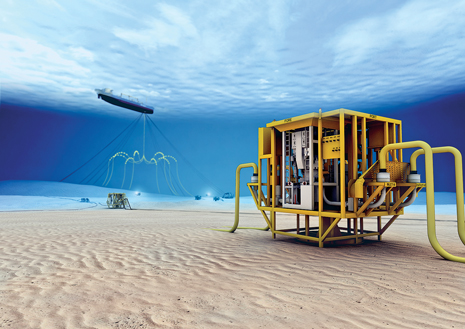 |
| Subsea boosting offers unique and field-proven systems, aimed to provide comprehensive technical solutions to help increase efficiency in oil and gas developments worldwide. Photo courtesy of OneSubsea. |
|
Development of the first subsea boosting systems began in the 1990s, with the intention of providing cost-effective solutions, to enable accelerated and prolonged production plateaus for economically marginal subsea fields. Subsea boosting provides the ability to tie back fields to existing production facilities, opening up greater potential for field development. Through gains in subsea boosting, the industry saw the world’s first subsea multiphase pump installed on the Shell-operated Draugen field in 1994. The pump boosted the production over a distance of 5.6 mi to the main platform from the Rogn South satellite field. The boost helped to successfully increase the production by an additional 5,000 bopd. Having accumulated approximately 1.5 million hr of subsea operational experience, these systems are capable of reliable operations in a variety of subsea applications, Fig. 1.
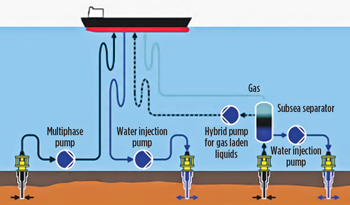 |
| Fig. 1. Various applications of subsea pumps. |
|
MULTIPHASE PUMPING APPLICATIONS
Multiphase pumps provide enhanced hydrocarbon recovery in a variety of
applications:
- Improve production profiles and maximize production plateau from deepwater developments
- Increase the reach of satellite fields and, thereby, utilize existing infrastructures
- Increase the production rate for satellite developments or potentially increase the total recoverable reserves
- Maintain production rates at increased water cuts
- Balance wellhead performance from comingled multi-well or multi-template field completions
- Inject raw seawater at reservoir pressure
- Inject produced water, reducing load on topside water handling equipment.
Field scenarios likely to benefit from a boosting application include:
- Incorporation into existing production facilities, to enhance production rate and total recovery
- New developments of medium-and-small sized fields in developed areas as satellites, by utilizing existing in-field gathering, processing and transport facilities
- Developments in remote areas with no existing infrastructure
- Deepwater development (in combination with floating production units)
- Enabling extended-reach satellite technology and long tie-back distances.
MULTIPHASE PUMP DEVELOPMENT
Start-up of the first multiphase pump development began in 1986, resulting in the selection of the helicoaxial pumping concept to provide the platform for flexible and robust boosting solutions. The helicoaxial/Poseidon concept has been maintained as the core of the multiphase boosting technology. The concept has proven to be efficient, durable, reliable and flexible with regard to various process conditions. Continuous improvements of the hydraulic (rotor/stator) design have been implemented throughout the past 25 years, Fig. 2.
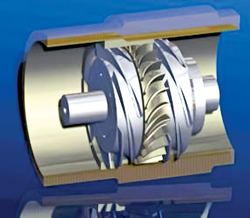 |
| Fig. 2. Subsea boosting water-depth milestones. |
|
HELICOAXIAL PUMP EVOLUTION
The evolution of the helicoaxial concept has been managed and developed along two dimensions over the last 15 years, Table 1:
- Performance increase demanded by the market
- Lessons learned from in-field operational data.
| Table 1. Summary of design changes since 1998. |
|

|
Market-driven performance improvement. Since 2000, oil companies have moved into deeper water and lower-permeability reservoirs, and toward higher well shut-in pressure, thus creating an accelerated demand for development of the corresponding boosting technology. The greatest “leap” in technology has been the increase in pressure rating from 3,000 to 15,000 psi, and the increase of pump differential pressure from 500 to 3,000 psi. Both of these advances relied on several years of developmental work, Fig. 3.
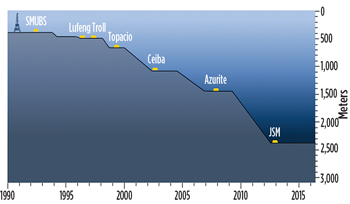 |
| Fig. 3. Helicoaxial multiphase boosting impeller and stator. |
|
Hybrid pump system. For applications where actual gas volume fraction (GVF) is a maximum of 30%, and the differential pressure is very high, the development of a hybrid pump system was introduced, combining single-phase and multiphase pumping technology. A hybrid pump includes helicoaxial multiphase impeller stages on the same shaft, and placed upstream of a stack of conventional single-phase impellers. The main challenge in hybrid pump development was to handle the flow transition between the two impeller types. The hybrid pump system is being utilized on Total’s Pazflor field, deepwater West Africa.
Higher differential pump pressure. Extremely high differential pressures are needed for production from the deepwater, low-permeability reservoirs. By working in close cooperation with the operators to refine the original design of the pump, a redesign has allowed the pump to achieve differential pressures up to 2,900 psi. The redesign implements a conventional balance piston (as applied to single-phase pumps), which relieves the main thrust-bearing loads. The challenges have been to make this design reliable for a multiphase flow under all flowing conditions. After years of creation and application of rigorous computer models and full-scale testing, the technology is now fully qualified and is operational in the offshore Brazil market.
Higher pressure rating. Due to deeper water depths, many fields now have high shut-in pressure. This requirement, combined with regulations not allowing credit of external hydrostatic pressure when calculating design pressure, has created the need to design heavier walled housings for any pressure-containing components. Development efforts are underway to manufacture high-pressure components rated to 15,000 psi, Fig. 4.
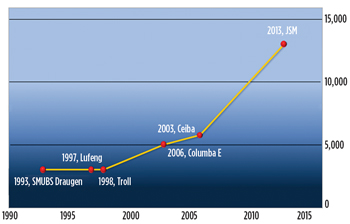 |
| Fig. 4. Subsea boosting pump design pressure milestones. |
|
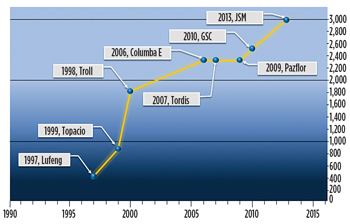 |
| Fig. 5. Subsea boosting shaft power milestones. |
|
Fiber-optic pump control system. Due to long tie-back distances, along with demanding operational scenarios requiring larger amounts of data transfer, a dedicated fiber-optic pump control system has been developed. The control system was designed to ensure sufficient response times to upset process conditions and transfer of pump data. The control system is implemented with open architecture, enabling communication with industry standard equipment.
Power system. Significant improvements in the topside variable-speed drive transformers/power supply system have been achieved over the last decade. These improvements have extended the potential tie-back distance without the use of a subsea VSD, up to 30–60 mi, depending on field configuration. Subsea electrical penetrators and wet-mate connector systems with higher voltage/current/power have also been rapidly developed and qualified to meet the challenges of the more demanding field developments.
High-power motor. One of the consequences of higher differential pressure is the need for a more powerful motor. For the high-power motor design, focus has been placed on maintaining the basic design that has proven to be extremely reliable and also flexible when it comes to stretching the performance requirements. Currently, the design is available in 3.0 MW arrangement, and an ongoing development program will increase this to 4.0 MW in the next few years.
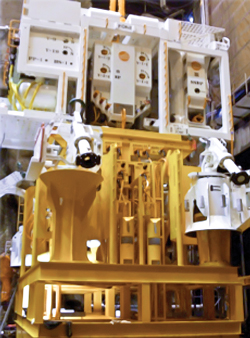 |
| Fig. 6. Albacora subsea raw seawater injection pump. |
|
NON–HELICOAXIAL CONCEPTS
Initiatives involving other subsea boosting concepts have had limited success to this point. Several attempts have been made to marinize the twin-screw pump technology for subsea boosting. At certain process conditions, the twin-screw concept has some inherent benefits, but has yet to prove reliable for multiple subsea applications.
Use of ESPs, either stand-alone inside a dedicated caisson, or in combination with seabed booster pumps, are a promising concept, but the ESPs still lack the reliability required by most operators for subsea operation. For future development of typical Paleagene formations requiring extreme pressure increase, a dual-boost concept involving in-well ESPs, combined with seabed pumps, may offer an attractive solution.
LESSONS LEARNED/IMPROVEMENTS
In addition to the improvements required to meet the demand for higher power/performance pumps, lessons learned from gaining a recorded 1.5 million operating hours for subsea booster pumps under challenging conditions has helped to refine the equipment and system designs. The data from operating runs, combined with inspection reports from numerous disassembles, has formed the basis for several types of improvements to the mechanical design, adding reliability and safety to mechanical seals, cooling circuits design, lube oil dewatering/filtering and impeller geometry.
RELIABILITY IMPROVEMENTS
The subsea environment is extremely unforgiving, when it comes to mechanical failures. The costs of unplanned subsea repair operations and interrupted production are highly undesired and detrimental to field development. In the subsea boosting arena, the same pump concept has been refined over the past 15 years, with changes progressing through small-scale, large-scale, and finally, prototype testing prior to in-field application. A rigorous testing program is implemented for all components prior to assembly, and an extended full systems site integration test is conducted, including all components and subsystems, prior to deployment. Statistical data indicate that helicoaxial subsea pump design offers a mean time to failure (MTTF) of greater than 12 years for the retrievable unit.
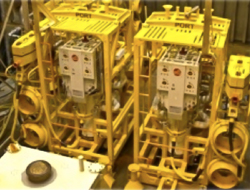 |
| Fig. 7. Pazflor subsea pump module |
|
SUBSEA BOOSTING PROJECTS
Albacora field, Petrobras, Brazil. Petrobras decided in 2006 to re-pressurize Albacora field using a subsea seawater injection system. The increased water injection rate, in combination with new subsea production systems, will increase production from the field to an estimated 45,000 bopd.
An EPC contractor was chosen in the spring of 2007 for the injection system design, and to supply three raw subsea water injection pump/filter systems. The systems are positioned in three different locations for injection of filtered seawater in up to eight subsea injection wells. Topside drive and control systems for the pump/filter modules are positioned on the production platform. Water depths for the Pump/Filter Module installations are ranging from 1,200 to 1,300 ft, and tieback distances from the pump station to the production platform (umbilical length) range from 13,000 to 32,800 ft.
The scope of supply consists of three vertically mounted subsea pump/filter modules, which are installed on mud mat/pump base structures adjacent to the daisy-chained water injection X-mas trees. Two pump systems will inject filtered seawater into three injection wells, each, and one pump system will inject seawater into two injection wells, for a total of eight injection wells. One complete spare pump module is also included in the scope. Three topside pump variable-speed drives (VSD), a hydraulic power unit (HPU), and pump control systems, as well as, a control and power umbilical for control and drive of the pump unit, will be installed.
Pazflor project, Total, Angola. The first-ever subsea pumping system in Angolan waters was successfully put into operation in September 2011. The pumping system consisted of three liquid/gas separation stations, each consisting of two hybrid pumps working in parallel.
Due to uncertainty related to the amount of gas carry-under to be expected downstream of the separator, combined with the requirement for a fairly large differential pressure, Total decided to combine single-phase centrifugal pumps with the multiphase helicoaxial technology. The pump supplier entered a qualification program with Total in 2006, with the aim of qualifying a gas-tolerant, single-phase pump for the Pazflor project, resulting in a hybrid pump design. The qualification program also focused on verifying the pump’s ability to start with a cold, highly viscous fluid inside. A successful test was completed in first-quarter 2007 and the contract was signed in mid-2007.
The pump system was delivered as part of a subcontract to the Pazflor SPS supplier. The scope included two pump modules for each subsea separation module working in parallel. The pump modules also included a re-circulation choke and a single-phase flow meter. The two pump modules are supplied with power and hydraulics, and controlled from a topside-located power and controls module (PCM). The pump system was built, tested and shipped to the main contractor site for integrated testing of the separation station, before final transport to Angola. All pumps were commissioned and successfully put into operation during September 2011.
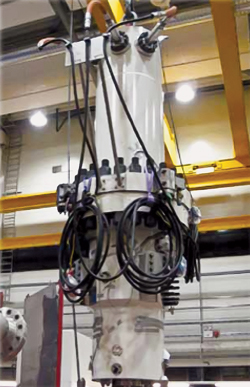 |
| Fig. 8. Jack and St. Malo subsea qualification pump. |
|
Jack and St. Malo project, Chevron, Gulf of Mexico. The Jack/St. Malo deepwater project comprises the joint development of the Jack and St. Malo oilfields, located within 40 km from each other. Jack field lies in Walker Ridge Blocks 758 and 759 at a water depth of 7,000 ft. St. Malo field lies in Walker Ridge Block 678 at a water depth of 2,100 ft. The deepwater project was approved by Chevron and its partners in October 2010. Production start-up is expected in 2014. The scope of supply consists of three single-pump stations; centrifugal subsea single-phase pumps; subsea electrical power components, including high-voltage, wet-mateable connectors and subsea transformers; and a subsea pump control system. The contract covers installation, intervention and testing tools, and all project management, engineering, Q-HSE and administration services to fulfill the project deliverables.
The main areas for challenges in subsea pumping are related to pressure containment at great depths and long tie-back distance. Due to the nature of the reservoir in this region, there can be significant differences in normal flowing pressure and the shut-in pressure. The water depth at Jack and St. Malo is in the 7,200-ft range. Consequently, the installation and resulting subsea layout is an engineering challenge that requires experience, expertise and efforts beyond standard subsea systems.
The long tie-back distances (up to 12 mi) to both Jack and St. Malo fields reinforce the need to have high-voltage drive and power transmission systems. To achieve electrical transmissions over the long distances, a power system is required with subsea transformers and HV wet mateable connectors. 
ACKNOWLEDGMENTS
This article was adapted from “Evolution of subsea boosting: A review of past and present projects,” OTC paper 24263, presented at the Offshore Technology Conference in Houston, Texas, May 6-9, 2013.
|
The authors
PHILLIP LUCE is business development/sales manager for OneSubsea in their Subsea Boosting and Process System. Mr. Luce holds a BS degree in engineering from University of Louisiana at Lafayette and started his career in subsea drilling with Vetco Gray, where he also gained experience in HPHT wellhead design and high-fatigue tubular connectors.
JARLE MICHAELSEN is regional manager in North America for the Subsea Processing division of OneSubsea. Mr. Michaelson holds a MS degree in thermodynamics from NTNU (Trondheim). He has worked in the oil and gas industry for 25 years, mostly with advanced production systems, including subsea separating and boosting.
NILS ARNE SØLVIK is V.P., Emerging Technologies and Processing Systems for OneSubsea. Mr. Sølvik obtained his MS degree in electrical power engineering from Norwegian Institute of Technology. He was sales manager for subsea pumping systems with Framo Engineering in 2003, and later become responsible for subsea pumps and processing systems sales in the Western Hemisphere.
|
|












